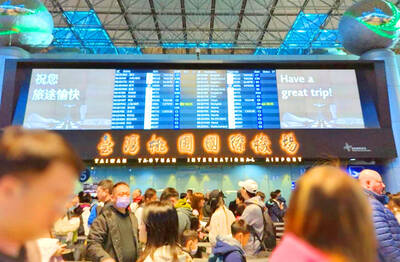A Taiwanese research team has found a way to mimic the flavor of civet coffee — a beverage traditionally produced from the beans of digested coffee cherries found in the scat of wild common palm civets in Indonesia.
The passage of the beans through the civets’ intestines is said to give the coffee a unique flavor which is highly prized by connoisseurs, and the resulting product sells for gourmet prices.
National Pingtung University of Technology and Science vice dean Hsieh Pao-chuan (謝寶全), who headed the team, said that due to the questionable authenticity of much of the civet coffee on the market, and the poor quality of beans produced by caged civets, beans that can be proven to have come from wild civets are the most highly prized.
On a field trip to Indonesia with a team of scientists from the university’s department of food science, Hsieh said he had managed to extract 136 strains of bacteria from the intestines of civets, and had isolated 16 which had particular effects on Mandheling coffee beans. The researchers monitored the changes with experiments using gas chromatography.
After seven years of experimentation, Hsieh and his team managed to perfect a process for treating beans that produced “civet coffee” from the laboratory.
According to Hsieh, the lab-produced civet coffee has a strong aroma of fruit and flowers, and tastes of caramel, cinnamon and chocolate, adding that the coffee had a fruit-like hint of acidity in its aftertaste.
Fermentation of the lab-produced civet coffee is entirely managed by the lab and takes between 16 and 24 hours, Hsieh said, adding that compared with the original, their product is more sanitary and has only half the caffeine content.
The laboratory is currently pricing its “civet coffee” at NT$4,000 per 0.45kg, Hsieh said, adding that if the lab found ways to mass-produce it the price would drop.
Coffee shop owners said that at the price the team is currently asking, each cup of coffee would cost about NT$100, making the beverage a luxury product.

Three Taiwanese airlines have prohibited passengers from packing Bluetooth earbuds and their charger cases in checked luggage. EVA Air and Uni Air said that Bluetooth earbuds and charger cases are categorized as portable electronic devices, which should be switched off if they are placed in checked luggage based on international aviation safety regulations. They must not be in standby or sleep mode. However, as charging would continue when earbuds are placed in the charger cases, which would contravene international aviation regulations, their cases must be carried as hand luggage, they said. Tigerair Taiwan said that earbud charger cases are equipped

Foreign travelers entering Taiwan on a short layover via Taiwan Taoyuan International Airport are receiving NT$600 gift vouchers from yesterday, the Tourism Administration said, adding that it hopes the incentive would boost tourism consumption at the airport. The program, which allows travelers holding non-Taiwan passports who enter the country during a layover of up to 24 hours to claim a voucher, aims to promote attractions at the airport, the agency said in a statement on Friday. To participate, travelers must sign up on the campaign Web site, the agency said. They can then present their passport and boarding pass for their connecting international

Temperatures in northern Taiwan are forecast to reach as high as 30°C today, as an ongoing northeasterly seasonal wind system weakens, the Central Weather Administration (CWA) said. CWA forecaster Tseng Chao-cheng (曾昭誠) said yesterday that with the seasonal wind system weakening, warmer easterly winds would boost the temperature today. Daytime temperatures in northern Taiwan and Yilan County are expected to range from 28°C to 30°C today, up about 3°C from yesterday, Tseng said. According to the CWA, temperature highs in central and southern Taiwan could stay stable. However, the weather is expected to turn cooler starting tonight as the northeasterly wind system strengthens again

Taiwan sweltered through its hottest October on record, the Central Weather Administration (CWA) said yesterday, the latest in a string of global temperature records. The main island endured its highest average temperature since 1950, CWA forecaster Liu Pei-teng said. Temperatures the world over have soared in recent years as human-induced climate change contributes to ever more erratic weather patterns. Taiwan’s average temperature was 27.381°C as of Thursday, Liu said. Liu said the average could slip 0.1°C by the end of yesterday, but it would still be higher than the previous record of 27.009°C in 2016. "The temperature only started lowering around Oct. 18 or 19